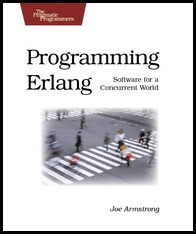
I’ve ordered my copy.
In this blog you'll find lots of programming and technology, a little music, a little personal, and a sprinkle of productivity geeking. The opinions expressed here are my own and don't necessarily reflect the opinions of anyone else.

I’ve ordered my copy.
Via: The Weekly Squeak: ‘Smalltalk is cool again’, says Gartner
There is an article from a Gartner analyst talking about a renewed interest in Smalltalk. Speaking for myself, I’ve come around to Smalltalk over the last couple of years and I’m very glad that I did. It’s one of the coolest languages/platforms I’ve ever laid my hands on.
In fact, in case you were wondering, I’ve temporarily put Erlang aside to go back and visit Smalltalk land. It’s just much more productive when you have limited time available.
I finished reading Joe Armstrong’s “Programming Erlang” book a couple of nights ago. It’s a great introduction to Erlang as well as a great programming book. I’ve always loved the Pragmatic Programmer books, and this one is no exception. It’s filled with non-trivial working examples and pointers to more information. It left me feeling ready to dive into the Erlang docs and write some code!
So, that’s exactly what I’m going to do. I’m currently plotting a program that I’m going to write in Erlang. I want to make sure that it’s non-trivial and that it benefits from concurrency. I’ll loop you in when my scheme is ready to hatch.
I just listened to a good podcast interview with Joe Armstrong on Software Engineering Radio. Joe talks about the history of Erlang, its features, how the VM is implemented, and how you can use it to scale on multi-cores or across multiple machines. It’s a good introduction to what Erlang is from the man himself.
I’ve been tearing through Joe Armstrong’s book “Programming Erlang”. I started reading it about 14 days ago, and I’m already in Chapter 17. It’s a well written book and a great introduction to the language and some key libraries.
I think the reason I’m working through it at such a rapid clip is that Erlang has captured my imagination. I’m fascinated by how easy it is to program multi-process applications and distribute those processes across machines. I’ve written multi-threaded code in Java, Python, and Common Lisp. Erlang is BY FAR the easiest language for writing MP code.
I can’t wait to finish the book and write my own application. I’m forcing myself to finish the book first because I want to make sure I know all the right tricks before I get started. I think that’s the right idea because I’m now learning about Mnesia and soon I will learn about advanced OTP techniques.
I can’t convey how excited I am by this language/platform. I saw my friend Jeff last night and I bored him to death as I gushed about Erlang. He mentioned that he had recently posted about CouchDB and that it would be cool to develop something social on top of that. Indeed…
OK, I couldn’t resist. I pulled the Erlang book off the shelf this week and dove in. I needed a distraction from work, then the whole idea of writing concurrent programs caught my fancy, and I saw the syntax that made me go hmmm… now I’m hooked.
First impression of “Programming Erlang” – it’s not for beginning programmers. Which I really like, but I can imagine that if you don’t have programming experience, you’d struggle. Also, it helps alot to know another functional language (like Lisp) when Joe starts talking about list comprehensions and anonymous functions. I would rate the book at the "advanced” level.
All that said, I’m loving the book and loving learning the language. It’s entertaining and gives me the excuse to use Emacs, which I don’t use often enough these days. :-) I’m using Luke Gorrie’s excellent Distel mode for Emacs.
I’m going to try to refrain from giving you a blow-by-blow of my Erlang experience until I get to concurrent programming. Then, all bets are off. :-)
 I’ve been thinking about trying out Erlang for a couple of years. Last night, my wife and I were in the bookstore… alone… with time to look at books. I picked up “Programming Erlang”. Reading through the cover and some of the front matter drew me in. So, after some deliberation, I bought it.
I’ve been thinking about trying out Erlang for a couple of years. Last night, my wife and I were in the bookstore… alone… with time to look at books. I picked up “Programming Erlang”. Reading through the cover and some of the front matter drew me in. So, after some deliberation, I bought it.
I read through Chapter 2 last night. Boy, Erlang is unique. However, I think I’m going to enjoy it.
I’ve put it on the bookshelf for now. I have some other reading and techie stuff to knock out before I really dive in. But, I’m getting excited.
One of the things I’ve steadily grown more passionate about over the last 6 months or so is Enterprise 2.0. I characterize it as the move of Web 2.0 technologies and ideas into business contexts. The reason I’m so passionate about it is because I’m witnessing the technologies that I’ve been using in my private life move into the enterprise and make meaningful contributions. In addition, these technologies and ideas usually challenge the status quo of business and it’s fascinating to watch businesses respond to this.
If you agree, or your just curious, please join me on EnterpriseBlend. Hope to see you there!
